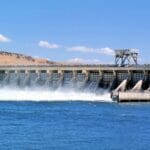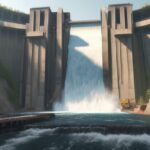If you’re curious about hydroelectric power and the wonders it holds, you’ve come to the right place. In this article, we’ll delve into the fascinating world of hydroelectric power by presenting ten intriguing facts that will leave you in awe. From its historical significance to its potential for a sustainable future, hydroelectric power is an energy source we cannot ignore. So, fasten your seatbelt as we embark on a journey to discover ten fascinating facts about hydroelectric power.
Key Takeaways:
- One of the largest hydroelectric power plants is located on the Yangtze River in China.
- Hydropower can have negative environmental impacts.
- Hydropower can be generated without the need for a dam.
- Every state in the US uses hydropower as a source of electricity.
- Hydroelectricity is particularly useful in emergency situations.
- Hydropower is a global source of energy.
- Hydropower is considered to be a cleaner alternative to fossil fuels.
- Hydroelectric power is generated through the power of water.
- The cost of hydroelectric power is 5 cents per Kwh.
- Hydroelectric power was first used for grinding corn in prehistoric times.
- China is the largest producer of hydroelectric power.
- The USA is the smallest producer of hydroelectric power.
- Hydroelectric power is produced in 150 countries globally.
- Hydroelectric power accounts for 16% of total global consumption.
- Hydroelectric power can be generated using dams, pumped storage, run-of-the-river, and tidal power.
10 Facts About Hydroelectric Power

Hydroelectric power is a fascinating renewable energy source that harnesses the power of water to generate electricity. In this article, we will explore some intriguing facts about hydroelectric power that highlight its significance in addressing renewable energy challenges. So, let’s dive in and discover these remarkable facts!
Fact 1: One of the largest hydroelectric power plants is located on the Yangtze River in China.
China boasts one of the largest hydroelectric power plants in the world, situated on the majestic Yangtze River. The Three Gorges Dam, a colossal engineering marvel, generates an astounding amount of clean energy, contributing significantly to China’s power supply.
Fact 2: Hydropower can have negative environmental impacts.
While hydroelectric power is a clean and renewable energy source, it is essential to acknowledge that it can have negative environmental impacts. The creation of dams can disrupt ecosystems, affect fish migration patterns, and alter river habitats. Balancing the benefits and environmental consequences is crucial in harnessing hydropower sustainably.
Fact 3: Hydropower can be generated without the need for a dam.
Contrary to popular belief, hydropower can also be generated without constructing large dams. Technologies such as run-of-the-river systems, which utilize the natural flow of rivers, and pumped storage, which involves storing excess electricity by pumping water to higher elevations, offer alternatives that minimize the need for dam construction.
Fact 4: Every state in the US uses hydropower as a source of electricity.
Hydropower plays a significant role in the energy landscape of the United States. In fact, every state in the country utilizes hydropower as a source of electricity. From the iconic Hoover Dam in Nevada to smaller-scale projects across the nation, hydroelectricity contributes to the diverse energy mix in the United States.
Fact 5: Hydroelectricity is particularly useful in emergency situations.
In times of emergencies or natural disasters, hydroelectric power proves to be a reliable energy source. Unlike other forms of electricity generation that may heavily rely on fuel supplies, hydroelectric power plants can swiftly respond to sudden demand, providing power to support critical services and emergency operations.
Fact 6: Hydropower is a global source of energy.
Hydroelectric power is not limited to specific regions; it is truly a global energy source. With hydroelectric power plants dotted across the globe, countries such as Canada, Brazil, and Russia harness the power of water to generate vast amounts of clean and renewable energy.
Fact 7: Hydropower is considered to be a cleaner alternative to fossil fuels.
Compared to fossil fuel-based power generation, hydroelectric power is widely recognized as a cleaner alternative. Hydropower plants produce minimal greenhouse gas emissions, contributing to the reduction of air pollutants and the fight against climate change.
Fact 8: Hydroelectric power is generated through the power of water.
The fundamental principle behind hydroelectric power is utilizing the power of flowing water to generate electricity. Water flowing downstream or falling from a height possesses kinetic energy, which can be harnessed by turbines to turn generators, converting this energy into electricity.
Fact 9: The cost of hydroelectric power is 5 cents per Kwh.
One of the advantages of hydroelectric power is its relatively low cost. On average, the cost of hydroelectric power production is around 5 cents per kilowatt-hour (kWh), making it an economical choice for generating electricity on a large scale.
Fact 10: Hydroelectric power was first used for grinding corn in prehistoric times.
The roots of hydroelectric power can be traced back to ancient times. In prehistoric periods, early civilizations harnessed the power of flowing water to grind corn and perform various mechanical tasks. This ancient use of hydropower laid the foundation for the modern-day hydroelectric energy industry.
In conclusion, hydroelectric power is an essential and fascinating element of the renewable energy landscape. By understanding these ten facts about hydroelectric power, we can appreciate its global significance, environmental considerations, and its potential in shaping a sustainable energy future.
Sources:
1. 20 Fun facts about Hydroelectric Power!
2. Hydroelectricity Facts: History, Science & More
Did you know there are 10 fascinating facts about hydroelectric energy? Discover them here: 10 facts about hydroelectric energy
Learn about the incredible power of hydroelectricity with these 10 intriguing facts: 10 facts about hydroelectricity
Explore the wonders of hydropower through 10 captivating facts that will leave you amazed: 10 facts about hydropower
Hydroelectric Power Plants: Unveiling 10 Fascinating Facts

Hydroelectric Power Plants Can Vary in Size and Capacity, from Small-Scale Installations to Large-Scale Dams
Hydroelectric power plants offer a remarkable solution in the pursuit of renewable energy. They come in various shapes and sizes, serving different purposes. In this article, we will uncover ten captivating facts about hydroelectric power to expand your knowledge on this sustainable energy option.
Key Takeaways:
- Small-scale hydropower plants hold economic and ecological appeal as a viable means of electricity production[^1^].
- Small hydro refers to plants that generate between 10 and 30 MW, further categorized into mini hydroelectric plants (100 kW–1 MW), micro hydroelectric plants (5–100 kW), and pico hydroelectric plants (<5 kW)[^2^].
- Large hydropower plants, such as the Three Gorges Dam in China, possess a capacity of over 30 megawatts (MW)[^2^].
- Run-of-the-river systems and pumped storage technology allow hydropower generation without the need for dams[^2^].
- Every U.S. state capitalizes on hydropower as an energy source[^2^].
- Hydroelectric power demonstrates reliability in emergency situations, flexibly responding to sudden demand[^2^].
- Countries like Canada, Brazil, and Russia extensively harness the energy of water, exhibiting the global reach of hydroelectric power[^2^].
- With minimal greenhouse gas emissions, hydroelectric power serves as a cleaner alternative to fossil fuels[^2^].
- Turbines and generators utilize the power of flowing water to generate hydroelectric power[^2^].
Fact 1: Small-Scale Hydropower Plants Provide Attractive Electricity Production Solutions
Small-scale hydropower plants have gained significant attention due to their appealing economic and ecological benefits. These installations offer a sustainable solution for electricity production, ensuring a reduced carbon footprint and lower operating costs[^1^].
Fact 2: Categorizing Small Hydropower Plants by Size and Capacity
To better classify small hydropower plants, they can be categorized into four distinct groups based on size and capacity. These groups include pico hydroelectric plants, generating less than 5 kilowatts; micro hydroelectric plants, with a capacity ranging from 5 to 100 kilowatts; mini hydroelectric plants, producing between 100 kilowatts and 1 megawatt; and small hydroelectric plants, generating 1 to 10 megawatts[^2^].
Fact 3: Understanding Large-Scale Hydropower Plants
In contrast to their smaller counterparts, large hydropower plants exhibit greater capacity, surpassing 30 megawatts (MW). The Three Gorges Dam in China stands as a remarkable example of a large-scale hydropower plant, showcasing the immense power and potential of these installations[^2^].
Fact 4: Alternative Technologies: Run-of-the-River Systems and Pumped Storage
Hydropower can also be harnessed using innovative technologies that eliminate the need for traditional dam construction. Run-of-the-river systems leverage the natural flow of water to generate energy, while pumped storage involves the storage and release of water to drive turbines, producing electricity on-demand[^2^].
Fact 5: Widespread Integration: Hydropower in Every U.S. State
Hydropower plays a significant role in the United States’ energy landscape, with each state utilizing this renewable source for electricity generation. By harnessing the power of water, the country embraces a diversified energy portfolio and reduces reliance on non-renewable fossil fuels[^2^].
Fact 6: Reliability in Action: Hydroelectric Power’s Immediate Response
Hydroelectric power offers a distinctive advantage in times of emergencies or sudden spikes in demand. Unlike some other forms of energy generation, hydroelectric power plants can swiftly respond to fluctuating electricity requirements, delivering reliable and consistent energy supply[^2^].
Fact 7: A Global Energy Source: Countries Harnessing Hydropower
Hydropower’s global reach is truly impressive. Nations around the world, including Canada, Brazil, and Russia, extensively harness the power of water to generate electricity. This demonstrates the extensive potential and widespread adoption of hydroelectric power as a reliable energy source[^2^].
Fact 8: Minimal Environmental Impact: Hydroelectric Power’s Clean Profile
When compared to fossil fuel-based energy generation, hydroelectric power emerges as a cleaner alternative, characterized by minimal greenhouse gas emissions. By reducing carbon footprints, these plants contribute to the preservation of the environment and combat climate change[^2^].
Fact 9: Unleashing the Power: Turbines and Generators
One of the key components of hydroelectric power plants is the set of turbines and generators used to convert the power of flowing water into electricity. These vital mechanisms enable us to harness and utilize the energy potential locked within rivers and other water bodies[^2^].
In conclusion, hydroelectric power remains a fascinating field that holds immense potential in the realm of renewable energy. Its diversity in size, varied methodologies, and clean operation establish it as an integral component of sustainable energy generation. By capitalizing on small-scale installations and large-scale dams alike, we can tap into the remarkable power of water for a greener future.
Sources:
[^1^] ScienceDirect: Small Hydroelectric Plant – an overview.
[^2^] Wikipedia: Hydroelectricity – Wikipedia.
Hydroelectric Power: A Sustainable Energy Option with Minimal Environmental Impact
Hydroelectric power, also known as water power, is harnessed from flowing or falling water to generate electricity. It stands as a remarkable example of utilizing nature’s forces to meet the world’s energy demands sustainably. In fact, hydroelectric power is considered a sustainable energy option with minimal environmental impact. Let’s delve into ten captivating facts about hydroelectric power that highlight its significance and potential.
1. Largest Renewable Source of Electricity
Hydropower is currently the largest renewable source of electricity, generating more power than all other renewable technologies combined. It accounts for an impressive 54% of all renewable energy. This highlights its reliability and significance in the renewable energy transition. [^1^]
2. Potential for Future Expansion
With its immense potential, hydropower has the capability to play an even more important role in providing clean and reliable energy. As energy demands continue to rise, sustainable hydropower can step in as a key contributor. Its future expansion holds promise for achieving a greener and more sustainable energy landscape. [^2^]
3. Environmental Impacts
While hydroelectric power is hailed as a sustainable energy option, it is important to recognize that it can also have environmental impacts. The construction of large-scale dams can disrupt river ecosystems and negatively affect fish migration patterns. It is crucial to implement mitigation measures and strike a balance between energy production and environmental preservation. [^2^]
4. Social and Economic Considerations
Sustainable hydropower projects must go beyond their environmental impacts and also consider their social and economic aspects. Understanding the local communities and ensuring their involvement is essential for a successful and sustainable transition to hydropower. A holistic approach is necessary to maximize the positive impacts and minimize any potential negative consequences. [^3^]
5. Major Electricity Supplier
Hydropower currently supplies a remarkable one-sixth of the world’s electricity, which is equivalent to almost 4500 TWh. This highlights its significant contribution to meeting global energy demands and reducing reliance on fossil fuels. [^4^]
6. Crucial Enabler for Renewable Transitions
While solar and wind energy are rapidly growing in adoption, hydropower stands as a crucial enabler for secure transitions to these renewable sources. It provides a stable and reliable energy source, acting as a complementary power generation option when solar and wind resources are less available. [^5^]
7. Leading Source of Renewable Energy
As of 2016, sustainable hydropower accounted for up to 71% of the global supply of renewable energy. This reinforces its position as the leading source of renewable energy worldwide. With its low carbon footprint and substantial generation capacity, hydropower continues to make strides in driving sustainable development. [^6^]
8. Identifying Untapped Hydropower Potential
A global-scale framework has been developed to identify unused profitable hydropower potential that can be further developed. This initiative aims to utilize the untapped power of flowing water to unlock additional sustainable energy sources and support the growing global energy demand. [^7^]
9. Three Gorges Dam, China
The Three Gorges Dam in China is one of the largest hydroelectric power plants in the world. This massive structure harnesses the power of the Yangtze River, generating renewable energy on an unprecedented scale. However, it’s important to note that large-scale hydroelectric projects like this can have both positive and negative environmental impacts. [^1^]
10. Cleaner and Sustainable Alternative
Hydroelectric power provides a cleaner alternative to fossil fuels, as it emits minimal greenhouse gases during operation. Its sustainable nature, coupled with its low carbon footprint, positions it as a commendable choice in the global efforts to combat climate change and reduce reliance on non-renewable energy sources.
Key Takeaways:
– Hydropower is the largest renewable source of electricity, accounting for 54% of all renewable energy.
– It has the potential for future expansion and can play a more significant role in providing clean and reliable energy.
– Environmental impacts, such as disrupting ecosystems and fish migration, must be considered and mitigated.
– Social and economic aspects of sustainable hydropower projects are crucial for long-term success.
– Hydropower supplies one-sixth of the world’s electricity, equivalent to almost 4500 TWh.
– It acts as a crucial enabler for secure transitions to higher shares of solar and wind energy.
– Sustainable hydropower has been the leading source of renewable energy, accounting for up to 71% of the global supply.
– Untapped profitable hydropower potential is being identified globally for development.
– The Three Gorges Dam in China is a prominent example of a large hydroelectric power plant.
– Hydroelectric power is a cleaner and sustainable alternative with minimal greenhouse gas emissions.
Sources:
– Nature: “The potential for sustainable hydropower”
– Union of Concerned Scientists: “Environmental Impacts of Hydroelectric Power”
Hydroelectric Power: Maximizing Efficiency in Water Management, Flood Control, and Irrigation
Hydroelectric power plays a crucial role in water management, flood control, and irrigation. It offers controlled water releases, flood control capabilities, and integration with renewable energy sources. Let’s explore ten fascinating facts about hydroelectric power that highlight its significance in addressing these challenges.
Fact 1: A Critical Role in Water Management
Hydroelectric power plays a crucial role in maximizing efficiency in water management practices. By offering controlled water releases, it helps in regulating the flow and distribution of water resources. This is essential for ensuring a steady water supply for various purposes, including agriculture, industries, and domestic use.
Fact 2: Flood Control Capabilities
Another vital function of hydroelectric power is flood control. The infrastructure associated with hydropower helps in mitigating the damaging effects of floods by managing and diverting excess water. This helps protect communities and agricultural land from the devastating impact of floods.
Fact 3: Integration with Renewable Energy
Hydroelectric power is not only about electricity generation. It offers a clean and renewable energy solution that can be integrated with other sustainable energy sources. By combining hydroelectric power with solar or wind power, we can create a more reliable and consistent energy system while reducing dependence on fossil fuels.
Fact 4: Support for Irrigation
Hydropower infrastructure plays a crucial role in supporting agricultural practices through irrigation. By harnessing the power of flowing water, it enables the controlled release of water for irrigation purposes. This ensures that farmlands receive an adequate water supply, leading to increased crop yields and improved food security.
Fact 5: Affordable Energy Source
Hydroelectric power is an affordable source of energy. With lower operational costs compared to fossil fuel-based power plants, it offers a cost-effective solution for electricity generation. This affordability makes it an attractive option for both developed and developing countries.
Fact 6: Major Contributor to Renewable Electricity Generation
Hydropower is currently the largest source of renewable electricity generation worldwide. It generates more electricity than all other renewable technologies combined, accounting for over half of all renewable energy. This highlights its significant role in decarbonizing the power system and reducing greenhouse gas emissions.
Fact 7: Storage for Drinking and Irrigation Water
Apart from electricity generation, hydropower also provides valuable services such as storage for drinking and irrigation water. The reservoirs created by hydropower projects can store water during periods of excess supply, which can then be released during dry spells or droughts to ensure a continuous water supply for communities and agricultural activities.
Fact 8: Increased Resilience to Flooding and Droughts
Hydropower infrastructure enhances the resilience of communities to both flooding and droughts. By managing water flow and storage, it helps regulate water availability during extreme weather events. This reduces the vulnerability of societies to water-related disasters and improves their capacity to adapt to changing climate conditions.
Fact 9: Expansion Potential for Small-Scale Hydropower
Small-scale hydropower plants have gained attention for their economic and ecological attractiveness. With their capacity ranging from pico to small, they offer localized energy solutions that can be tailored to meet the needs of specific communities. Their expansion can contribute to increased electricity production while considering ecological aspects.
Fact 10: A Global Energy Source
Hydroelectric power is a truly global energy source, with various countries harnessing water power. Nations like Canada, Brazil, and Russia have made significant investments in hydroelectric infrastructure, benefiting from the abundant water resources within their territories.
Key Takeaways:
– Hydroelectric power plays a crucial role in water management, flood control, and irrigation.
– It offers controlled water releases, flood control capabilities, and integration with renewable energy sources.
– Hydropower supports efficient water management by regulating the flow and distribution of water resources.
– It helps in mitigating the damaging effects of floods by managing and diverting excess water.
– The integration of hydroelectric power with other renewable energy sources creates a more reliable energy system.
– Hydropower infrastructure supports agricultural practices through controlled water release for irrigation purposes.
– It is an affordable source of energy, making it attractive for both developed and developing countries.
– Hydropower is the largest source of renewable electricity generation worldwide, contributing to decarbonization efforts.
– It provides storage for drinking and irrigation water, helping ensure a continuous water supply.
– Hydropower infrastructure enhances community resilience to flooding and droughts.
– Small-scale hydropower has expansion potential, offering localized energy solutions with ecological considerations.
– Hydroelectric power is harnessed by various countries worldwide, including Canada, Brazil, and Russia.
Sources:
- Utilities One: Exploring the Role of Hydroelectric Power in Water Management
- Department of Energy: Benefits of Hydropower
FAQ
Q1: Where is one of the largest hydroelectric power plants located?
A1: One of the largest hydroelectric power plants is located on the Yangtze River in China.
Q2: What are some negative environmental impacts of hydropower?
A2: Hydropower can have negative environmental impacts, such as disrupting river ecosystems.
Q3: Is it possible to generate hydropower without the need for a dam?
A3: Yes, hydropower can be generated without the need for a dam through techniques like pumped storage, run-of-the-river, and tidal power.
Q4: Do all states in the US use hydropower as a source of electricity?
A4: Yes, every state in the US uses hydropower as a source of electricity.
Q5: In what situations is hydroelectricity particularly useful?
A5: Hydroelectricity is particularly useful in emergency situations due to its reliability and ability to provide a stable source of power.









